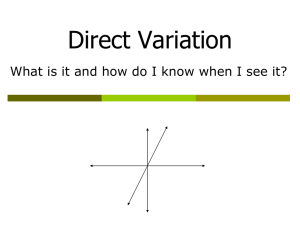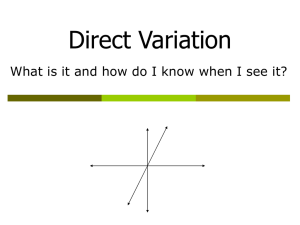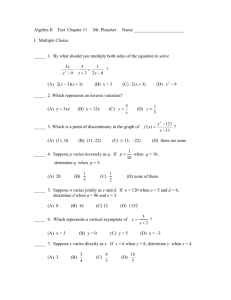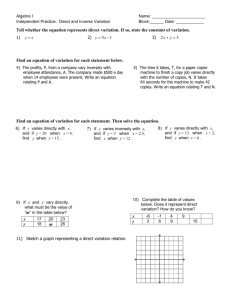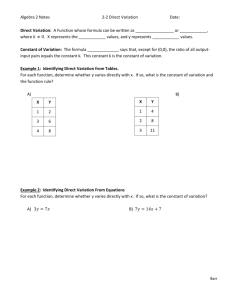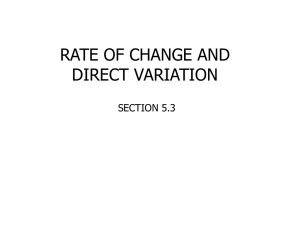Direct Variation
advertisement
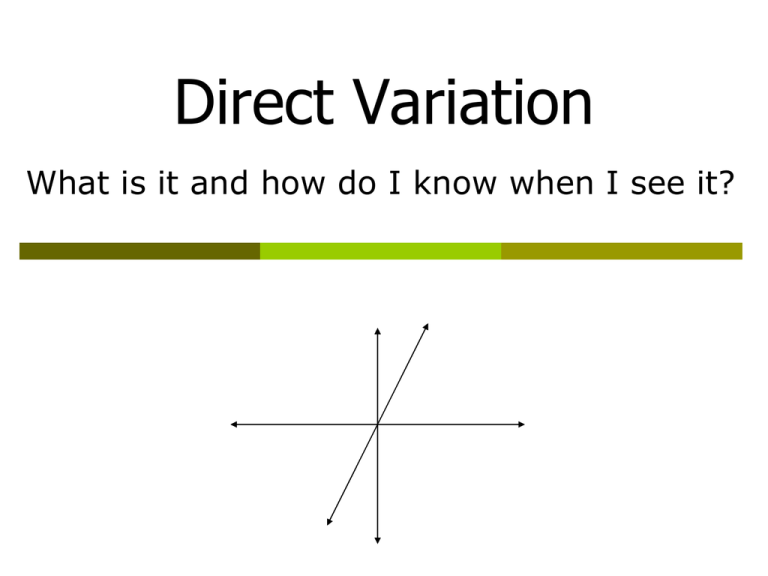
Direct Variation What is it and how do I know when I see it? Definition: Y varies directly as x means that y = kx where k is the constant of variation. (see any similarities to y = mx + b?) y Another way of writing this is k = x In other words: * the constant of variation (k) in a direct variation is the constant (unchanged) ratio of two variable quantities. Examples of Direct Variation: X 6 7 8 Y 12 14 16 Note: X increases, 6,7,8 And Y increases. 12, 14, 16 What is the constant of variation of the table above? y Since y = kx we can say k Therefore: x 12/6=k or k = 2 14/7=k or k = 2 16/8=k or k =2 Note k stays constant. y = 2x is the equation! Examples of Direct Variation: Note: X decreases, X 10 5 3 Y 30 15 9 10, 5, 3 And Y decreases. 30, 15, 9 What is the constant of variation of the table above? y Since y = kx we can say k Therefore: x 30/10=k or k = 3 15/5=k or k = 3 9/3=k or k =3 Note k stays constant. y = 3x is the equation! Examples of Direct Variation: X -4 -16 -40 Y -1 -4 -10 Note: X decreases, -4, -16, -40 And Y decreases. -1,-4,-10 What is the constant of variation of the table above? y k Since y = kx we can say Therefore: x y = ¼ x is the -1/-4=k or k = ¼ -4/-16=k or k = ¼ equation! -10/-40=k or k = ¼ Note k stays constant. What is the constant of variation for the following direct variation? Answer Now 0% 0% 0% 0% ½ 4. -½ 3. -2 2. 2 -2 -½ ½ Y -8 -16 12 -6 2 1. X 4 8 -6 3 Is this a direct variation? If yes, give the constant of variation (k) and the equation. X 4 8 12 18 Y 6 12 18 27 Yes! k = 6/4 or 3/2 Equation? y = 3/2 x Is this a direct variation? If yes, give the constant of variation (k) and the equation. X 10 6 4 2 Y 25 15 10 5 Yes! k = 25/10 or 5/2 k = 10/4 or 5/2 Equation? y = 5/2 x Is this a direct variation? If yes, give the constant of variation (k) and the equation. X 15 3 1 2 Y 5 26 75 150 No! The k values are different! Which of the following is a direct variation? 0% 0% 0% 0% D 4. Answer Now C 3. B 2. A B C D A 1. Which is the equation that describes the following table of values? 0% 0% 0% 0 20 = xy = = ½ 2x x 0% y Answer Now y 4. Y 5 1 6 10 -2 x 3. X 10 2 12 20 = 2. y = -2x y = 2x y= ½x xy = 200 y 1. Using Direct Variation to find unknowns (y = kx) Given that y varies directly with x, and y = 28 when x=7, Find x when y = 52. HOW??? 2 step process 1. Find the constant variation k = y/x or k = 28/7 = 4 k=4 X Y 7 28 ? 52 2. Use y = kx. Find the unknown (x). 52= 4x or 52/4 = x x= 13 Therefore: X =13 when Y=52 Using Direct Variation to find unknowns (y = kx) Given that y varies directly with x, and y = 3 when x=9, Find y when x = 40.5. HOW??? 2 step process 1. Find the constant variation. k = y/x or k = 3/9 = 1/3 K = 1/3 2. Use y = kx. Find the unknown (x). y= (1/3)40.5 y= 13.5 X Y 9 3 40.5 ? Therefore: X =40.5 when Y=13.5 Using Direct Variation to find unknowns (y = kx) Given that y varies directly with x, and y = 6 when x=-5, Find y when x = -8. HOW??? 2 step process 1. Find the constant variation. k = y/x or k = 6/-5 = -1.2 k = -1.2 X Y -5 6 -8 ? 2. Use y = kx. Find the unknown (x). y= -1.2(-8) Therefore: x= 9.6 X =-8 when Y=9.6 Using Direct Variation to solve word problems Problem: A car uses 8 gallons of gasoline to travel 290 miles. How much gasoline will the car use to travel 400 miles? Step Two: Find the constant variation and equation: k = y/x or k = 290/8 or 36.25 y = 36.25 x Step One: Find points in table X (gas) Y (miles) 8 290 ? 400 Step Three: Use the equation to find the unknown. 400 =36.25x 400 =36.25x 36.25 36.25 or x = 11.03 Using Direct Variation to solve word problems Problem: Julio wages vary directly as the number of hours that he works. If his wages for 5 hours are $29.75, how much will they be for 30 hours Step Two: Find the constant variation. k = y/x or k = 29.75/5 = 5.95 Step One: Find points in table. X(hours) Y(wages) 5 29.75 30 ? Step Three: Use the equation to find the unknown. y=kx y=5.95(30) or Y=178.50 Direct Variation and its graph y = mx +b, m = slope and b = y-intercept With direction variation the equation is y = kx Note: m = k or the constant and b = 0 therefore the graph will always go through… the ORIGIN!!!!! Tell if the following graph is a Direct Variation or not. No No Yes No Tell if the following graph is a Direct Variation or not. No Yes Yes No
